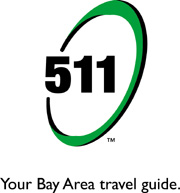Bay Area residents will get an early Christmas present when the Metropolitan Transportation Commission (MTC) officially activates its 511 phone- and Web-based traveler information system at a Dec. 6 ceremony in Walnut Creek. The new 511 number will join 411 and 911 on the list of easy-to-remember, three-digit phone numbers delivering important public services.

By John Goodwin
Published: December, 2002
Bay Area residents will get an early Christmas present when the Metropolitan Transportation Commission (MTC) officially activates its 511 phone- and Web-based traveler information system at a Dec. 6 ceremony in Walnut Creek. The new 511 number will join 411 and 911 on the list of easy-to-remember, three-digit phone numbers delivering important public services. Callers who dial 511 can use the toll-free service to get fare and schedule information for every ferry service in the Bay Area, as well as on-demand information about road conditions and traffic incidents on specific routes throughout the region, route fare and schedule information from dozens of rail and bus transit service providers plus operators of paratransit service for elderly or disabled riders and information about carpooling, vanpooling, and bicycling.
The Bay Area is the largest metropolitan area in the country, and the first in California, to activate the 511 service, which is being rolled out in stages nationwide. The launch is the result of a partnership between MTC, Caltrans, the California Highway Patrol, 35 different transit operators, 20 providers of paratransit services for elderly or disabled riders, and RIDES for Bay Area Commuters Inc., which supplies carpooling, vanpooling, bicycling, and other commute option information, including information about transportation to airports.
In tandem with the 511 phone service, MTC is launching a new Web portal at www.511.org for travelers who prefer to get their information online. The combination of phone and Web services is the successor to the Bay Area's six-year-old TravInfo® system. In addition to the memorable three-digit number, major advances in the 511 phone service include a state-of-the-art voice response system which eliminates the need to navigate your way through a push-button choice menu. New features now available at 511.org include an innovative online ridematching service that provides commuters a quick, easy, and free way to find others interested in sharing their ride to work in a carpool or vanpool.
"511 is all about customer convenience," said MTC Chair Sharon Brown. "It's easy to use and easy to remember."
The 511 system will become even more convenient in the months ahead. MTC's popular TakeTransit online trip planning service, which now includes route, fare, and schedule data for 18 Bay Area transit operators, will migrate to 511.org in early 2003, with information on every transit operator in the Bay Area. Also available in 2003, via both phone and Web, will be a service providing actual travel times from point to point along key freeway routes.
The speech technology itself is continually being refined as well. Because 511 is a voice-enabled system, there literally are as many different ways to ask for information as there are people in the Bay Area. Over the past few months, MTC and its engineering partners have been testing and monitoring the system to see how callers actually use it, and then making adjustments to improve the application. Among the adjustments was programming the phone system to understand different ways people might ask for the same thing-, ike "880," "Interstate 880," or "Nimitz Freeway."
"We'll keep fine-tuning the system as more people call in," noted project manager Emily Van Wagner of MTC. "Whether you go to the phone or go to the computer, 511 is a one-stop source of free information that all Bay Area travelers can use every day. Transit riders can call 511 to find out when the next ferry, bus, or train is scheduled, or what the fare will be. Drivers can find out about accidents or road closures, and then decide whether to take an alternate route or delay their trip."
511 is a free call from any conventional phone in the nine Bay Area counties. Charges from cell phones depend on the caller's plan. Major wireless carriers offering the 511 service in the Bay Area include AT&T, Cingular, Sprint, and T-Mobile.
The many contributors to the regional 511 partnership deliver a wide range of information and make the Bay Area 511 system one of the most comprehensive and innovative in the country. Among the innovations is the online ridematching service launched by RIDES for Bay Area Commuters.
"Go to 511.org," said RIDES Executive Director Catherine Showalter, "And with just a few clicks of the mouse, the new self-serve system enables commuters to find and contact potential carpool or vanpool partners who travel to and from the same area and who share the same work schedule. It's the perfect way for individuals who don't want to drive alone to fine someone to share their ride."
The online ridematching tool also can be accessed at www.rides.org. After registration is complete, a map appears showing approximate locations of potential carpool or vanpool partners and a corresponding list of contact information. Commuters then e-mail or call prospective rideshare partners, so arrangements can be made almost immediately. Those without Internet access can dial 511 and say "carpooling" or "vanpooling" and a consultant will enter their information into the system. The caller will then receive a list of potential carpool or vanpool partners in the mail.
The 511 service has been in the planning stages since July 2000 when the Federal Communications Commission and the U.S. Department of Transportation designated 511 as the national dialing code for travel information. By the end of 2002, more than a dozen separate 511 systems are expected to be operational around the U.S. The eventual goal of joining the disparate systems into a seamless nationwide service likely will take several more years, however.
John Goodwin works in the Metropolitan Transportation Commission's Public Information Office.


